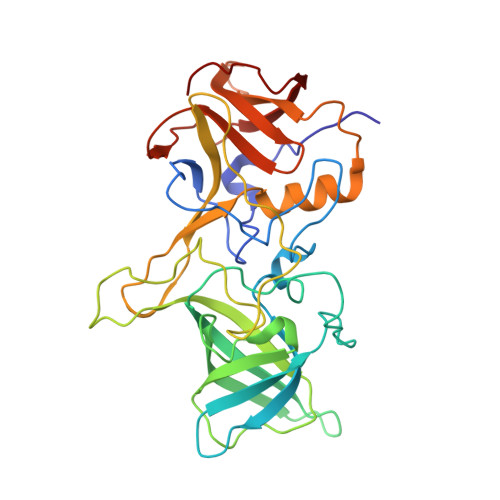Development of a broad-spectrum therapeutic Fc-nanobody for human noroviruses.
Hansman, G.S., Kher, G., Svirina, A.D., Tame, J.R.H., Hartley-Tassell, L., Irie, H., Haselhorst, T., von Itzstein, M., Rudd, P.A., Pancera, M.(2024) J Virol 98: e0070724-e0070724
- PubMed: 38953655
- DOI: https://doi.org/10.1128/jvi.00707-24
- Primary Citation of Related Structures:
8V95, 8V96, 8V97, 8V98, 8V99, 8V9A, 8VRU, 8VRV - PubMed Abstract:
Human norovirus was discovered more than five decades ago and is a widespread cause of outbreaks of acute gastroenteritis. There are no approved vaccines or antivirals currently available. However, norovirus inhibitors, including capsid-specific monoclonal antibodies (Mabs) and nanobodies, have recently shown promising results. Several Mabs and nanobodies were found to inhibit norovirus replication using a human intestinal enteroid (HIE) culture system and/or could block norovirus attachment to histo-blood group antigen (HBGA) co-factors. In our pursuit to develop a single broad-spectrum norovirus therapeutic, we continued our analysis and development of a cross-reactive and HBGA interfering nanobody (NB26). To improve NB26 binding capacity and therapeutic potential, we conjugated NB26 onto a human IgG Fc domain (Fc-NB26). We confirmed that Fc-NB26 cross-reacts with genetically diverse GII genotype capsid protruding (P) domains (GII.8, GII.14, GII.17, GII.24, GII.26, and GII.NA1) using a direct enzyme-linked immunosorbent assay. Furthermore, X-ray crystallography structures of these P domains and structures of other GII genotypes reveal that the NB26 binding site is largely conserved, validating its broad reactivity. We showed that Fc-NB26 has ~100-fold higher affinity toward the norovirus P domain compared to native NB26. We also found that both NB26 and Fc-NB26 neutralize human norovirus replication in the HIE culture system. Furthermore, the mode of inhibition confirmed that like NB26, Fc-NB26 caused norovirus particle disassembly and aggregation. Overall, these new findings demonstrate that structural modifications to nanobodies can improve their therapeutic potential.IMPORTANCEDeveloping vaccines and antivirals against norovirus remains a challenge, mainly due to the constant genetic and antigenic evolution. Moreover, re-infection with genetically related and/or antigenic variants is not uncommon. We further developed our leading norovirus nanobody (NB26) that indirectly interfered with norovirus binding to HBGAs, by converting NB26 into a dimeric Fc-linked Nanobody (Fc-NB26). We found that Fc-NB26 had improved binding affinity and neutralization capacity compared with native NB26. Using X-ray crystallography, we showed this nanobody engaged highly conserved capsid residues among genetically diverse noroviruses. Development of such broadly reactive potent therapeutic nanobodies delivered as a slow-releasing prophylactic could be of exceptional value for norovirus outbreaks, especially for the prevention or treatment of severe acute gastroenteritis in high-risk groups such as the young, elderly, and immunocompromised.
- Institute for Glycomics, Griffith University, Gold Coast Campus, Gold Coast, Queensland, Australia.
Organizational Affiliation:


















